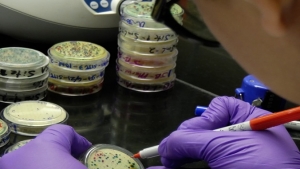The University of Hawaiʻi attracted $421.8 million in extramural funding in fiscal year 2019 (FY2019), topping $400 million for the first time in four years. That is a 9.2 percent increase over the $368.3 million in extramural funding UH brought in last year. Extramural funding is external investments from governmental agencies, industries and non-profit organizations that support research and training activities by university faculty and staff.
The research and innovation supported by the funding help to increase knowledge and provide solutions to improve the quality of life in Hawaiʻi and around the world.
Funding increases were seen at every level of UH, from community colleges to all three four-year campuses.
- UH System: $48.3M—35.8 percent increase
- UH Mānoa: $314.5M—4.5 percent increase
- UH Hilo: $17.1M—32.7 percent increase
- UH West Oʻahu: $8.2M—36 percent increase
- UH Community Colleges: $33.6M—9.7 percent increase
In federal funding alone, UH brought in $280.4 million in FY2019, an increase of more than $30 million from the previous fiscal year’s tally of $247.7 million.
“During the last few years, the University of Hawaiʻi, like most research institutions across the country, has had to endure the ebbs and flows in the extramural funding arena,” UH Vice President for Research and Innovation Vassilis L. Syrmos said. “In spite of this difficult environment, the dedication and hard work of our faculty, support staff and students all contributed to making FY2019 end on a high note for the UH research enterprise.”
Programs and personnel attracting the attention of funders include:
- Five junior researchers at UH Mānoa, who received an award of $10.4 million from the National Institutes of Health’s Centers of Biomedical Research Excellence. The funding supports the first center focusing on the interface between environmental microbiomes and human health.
- UH West Oʻahu, which received $2.5 million from the National Science Foundation’s Tribal Colleges and Universities Program for its Pūkoʻa Kani ʻĀina project. The project will enhance STEM education and create a STEM ecosystem at UH West Oʻahu by providing a STEM pipeline from high schools, community colleges and from its own campus to careers and post baccalaureate education.
- UH Maui College, which received a $1 million award from the National Science Foundation for its Project Kaihuwaʻa. The program aims to increase the academic success of low-income, talented students and improve overall retention, graduation and transfer rates.
About UH research
Research conducted by UH impacts the quality of life in the islands and around the world. As the state’s major research university, and because of Hawaiʻi’s tremendous geographic diversity, UH plays a prominent role in the state’s economic growth and development through its diverse and world-renowned research and innovation programs in astronomy, earth and ocean sciences, medicine and tropical agriculture.
UH Mānoa, the flagship campus of UH’s ten-campus system, is one of 115 universities, out of the 3,000 nationwide, to hold the distinction of being a Carnegie Research 1 university.
UH Mānoa is currently ranked 52 out of the top 400 public institutions of higher education when it comes to total research and development expenditures—federal government, state and local government, business, non-profit organizations and institutional sources. That’s according to the most recent National Science Foundation Higher Education Research & Development Expenditures Survey.


